Pacific Northwest Peace Pagoda: Coming Into Form
Written by: Rev. Senji Kanaeda and Glen Milner
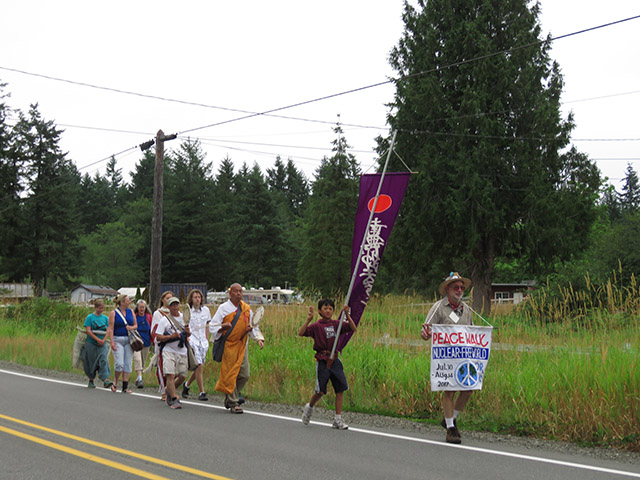
Peace walkers and other supporters, have over years funded and helped with development of the Peace Pagoda.
Photos by: Senji Kanaeda, Thomas Matsuda, Sally Noedel, Shōji Tomiyama
This year a unique Washington state peace pagoda will be completed after 44 years of effort, immediately adjacent to the world’s largest concentration of deployed nuclear weapons.
The Pacific Northwest Peace Pagoda is a Buddhist stupa that seeks to unite all sentient beings, regardless of race, creed or nationality, in the universal aspiration for genuine world peace. When done it will be 40 feet tall and about 44 feet across at the base. The stupa is rising just 110 feet from the property line of Naval Base Kitsap-Bangor, the location of eight Trident nuclear missile submarines.
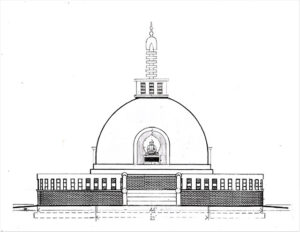
The effort is being led by Rev. Senji Kanaeda, who in 1995 was ordained as a Japanese Buddhist monk in the Nipponzan Myohoji order. He lives at the Nipponzan Myohoji Bainbridge Island Temple on nearby Bainbridge Island, and is particularly focused on promoting world peace.
The 3.8-acre pagoda site is owned by a peace organization, Ground Zero Center for Nonviolent Action, formed in 1977 in opposition to the nuclear weapons at the base. The Peace Pagoda and the adjacent Naval Base Kitsap-Bangor are approximately 20 miles northwest of Seattle near Hood Canal. Bainbridge Island is directly west of Seattle.
With a nuclear submarine base on one side, and an active gun range just down Clear Creek Road, the peace pagoda has become a place of tranquility amidst human violence. As the pagoda’s parts come together as they arrive from the U.S. and Japan, the vision and the meaning of the Pacific Northwest Peace Pagoda is coming into being.

The peace pagoda is inspired by traditional stupa designs, reflecting the original Indian style of a dome-shaped building topped by a spire. As with many stupas built since the time of Buddha Shakyamuni, this peace pagoda will entomb his relics.
In 2012 Ven. Gyangkaji Shakya, a monk from Kathmandu, Nepal, gave the relics to Rev. Senji Kanaeda. Three grains of relics are currently kept in the altar of the Nipponzan Myohoji temple in Bainbridge Island, waiting for the day when they will be enshrined next to Naval Base Kitsap-Bangor. When complete this will be the only Nipponzan Myohoji Peace Pagoda on the U.S. West Coast.
Rev. Kanaeda said, “The world is facing uncontrollable global warming and the risk of plunging into all-out war, including nuclear war, and there is no shortage of reasons to be pessimistic about the future. It is precisely at this time that Buddhism is practiced, and I sincerely hope that this pagoda will be a catalyst for awakening everyone to their Buddha nature, one of the three thousand realms of human nature that symbolically has been passed down through humanity. There have been quite a few difficulties in the construction, but I feel that it must be accomplished at all costs.”
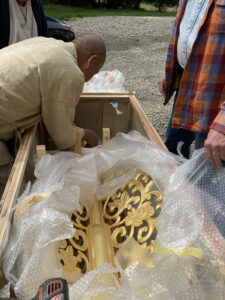
Rev. Senji Kanaeda and Rev. Gilberto Perez, also a monk, are leading the construction of the peace pagoda. Reverend Kanaeda has organized numerous peace walks each year, and provides much support to local and international peace activists and peace programs. Both men live at the Bainbridge Island temple.
The story of the Pacific Northwest Peace Pagoda is one of patience and persistence. In November 1980, Ven. Nichidatsu Fujii, founder monk of the Nipponzon Myohoji Buddhist order, declared that a pagoda would be built at Ground Zero to commemorate and support people being jailed for peace. Construction began in 1981, only to have permits revoked by Kitsap County in 1982. Permits for construction were finally granted by the county in 2019.
Since September work on the stupa has again been delayed, this time by a dispute with the company that has been forming the concrete on the dome. After a month on the job it became clear that the contractor was not equipped for the difficult task. The monks have since found a new contractor, and work on the concrete dome is scheduled to restart in February, 2025.
Rev. Kanaeda recently said of the concrete dome work, “Once we pass over this mountain, we can do much of the work ourselves. The most difficult part will be done.”
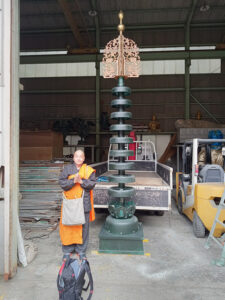
As of November, fabrication of the foundation, walls, and much of the dome have been completed. The Peace Pagoda is expected to be dedicated in 2025.
The Pacific Northwest Peace Pagoda is simple in form, and adorned with several special artisan-created elements that make the pagoda truly unique. Artists are creating relief panels depicting the life of the Buddha, while the stupa also will include a limestone statue of the Buddha’s first sermon, and a sōrin: an ornate brass top spire crafted in Japan, and sent by ship to Seattle.
The central Buddha statue was recently completed by Massachusetts Buddhist sculptor Thomas Matsuda. The three reliefs were created by Bainbridge artist and Quaker Craig Jacobrown.
The final stages of the project will include installation of the spire and decorative box atop the stupa, installation of the statue and reliefs depicting four scenes from the life of the Buddha, and the decoration of the exterior walls in the art deco style.
Other than concrete pouring, construction has relied entirely on volunteers, including the project manager, and the service of local U.S. residents. Material and spiritual support have also come from Japan. The Nipponzan Myohoji monks are extremely grateful for this kindness, and look forward to additional support from many people.
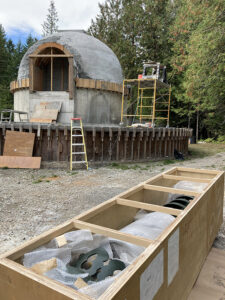
The Significance of Pagodas and Ancient Indian King Ashoka
Stupas (pagodas) are a traditional religious form that people first created as mounds of earth. Later they were built up in layers of bricks, clay, stone, and in Japan, wood. Stupas were built over the enshrined remains of the Buddha, his disciples, and awakened beings after the time of the Buddha. Sometimes these stupas are far from where those beings lived or died, so people could pay respects to those beings even from a distance.
After the Buddha’s paranirvana, followers cremated his body, divided his remains (relics) into eight portions, and built memorial towers (stupas) to house the remains.
A key figure in the spread of stupas was King Ashoka, a legendary 3rd century B.C. king in what is now India. King Ashoka built his empire with brutal tactics in war with neighboring countries, eventually achieving the unification of much of what is now India. But horrified by the carnage he had caused, Ashoka then renounced violence and became a Buddhist.
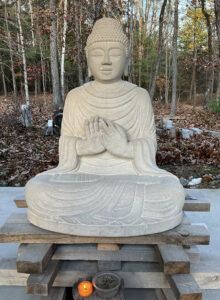
As a Buddhist emperor, King Ashoka was one of the greatest contributors to the spread of Buddhism across Asia. In particular he built 84,000 stupas throughout India, many of them containing relics of the Buddha and his disciples.
Ashoka also had erected what are now called Ashokan pillars, stone columns at the four Buddhist places of pilgrimage inscribed with his decrees in Prakrit script. The inscriptions are: (1) Do not kill any living thing, including animals; (2) Respect parents and elders and be polite; (3) Be considerate of the poor and always considerate of others; (4) Be tolerant of different beliefs and ideas; (5) Strive to live in peace and harmony.
By practicing these moral virtues, King Ashoka essentially advocated an ethical code of conduct that applies to everyone, regardless of religion.
In The Time Has Come (1982), the Most Venerable Nichidatsu Fujii wrote:
Na Mu Myo Ho Ren Ge Kyo
It is false to talk of peace
while possessing weapons
destined to take life.
When we talk of peace,
we must lay down all
murderous tools.
Rev. Senji Kanaeda, ordained as a Japanese monk in 1995, lives at the Nipponzan Myohoji Bainbridge Island Temple.
Glen Milner lives in Lake Forest Park, north of Seattle, and is a member of the Ground Zero Center for Nonviolent Action. He identifies with the Society of Friends.
